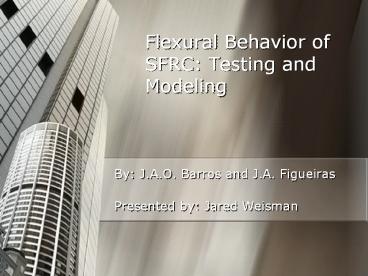Flexural Behavior of SFRC: Testing and Modeling - PowerPoint PPT Presentation
1 / 16
Title:
Flexural Behavior of SFRC: Testing and Modeling
Description:
SFRC Steel Fiber Reinforced Concrete. Act as crack 'arrestors' ... Covered with wet cloths. Kept at 65% humidity. Compression Behavior ... – PowerPoint PPT presentation
Number of Views:398
Avg rating:3.0/5.0
Title: Flexural Behavior of SFRC: Testing and Modeling
1
Flexural Behavior of SFRC Testing and Modeling
- By J.A.O. Barros and J.A. Figueiras
- Presented by Jared Weisman
2
Scope
- Contribution to ongoing research to model SFRC
structures - Experimental Investigation
- Layered model for analysis of SFRC cross sections
- Model and thin slab testing
3
Introduction
- SFRC Steel Fiber Reinforced Concrete
- Act as crack arrestors
- Used in pavements, overlays, floors, hydraulic
and marine structures, and repair and
rehabilitation - Properties of steel fibers in general
4
Test Backgrounds
- ASTM C1018
- JSCE-SF4
- Tensile Strain-Softening Law
- Fracture Energy, Gf
- 3 point bending tests with notched beams
5
Mix Proportioning
Main Variables w/c ratio, fiber percentage,
fiber aspect ratio (L to F ratio) S3 and S4
Compression behavior S2 Slab strips Fiber
types ZP30/.50 and ZX60/.80
6
Mixing
- Water, cement, aggregates, and sand were mixed
for 2 minutes, then fibers slowly added - Internal vibration was used for the compaction of
cylinder and prismatic specimens - Slabs used external vibration
- Covered with wet cloths
- Kept at 65 humidity
7
Compression Behavior
- Main Goal to define a s-e relationship to
simulate complete behavior of SFRC to be analyzed
- Test standard compressive testing machine,
specimens tested in a displacement controlled
condition - Normal stress-strain law doesnt sufficiently
take into account postpeak response of SFRC. One
using experimental data which takes into account
things like fiber geometry, volume fraction, and
fiber shape was needed.
8
Compression Results
9
More Compression Graphs
10
Tensile Behavior
Three-point bending tests were performed on
notched beams
Measurement of Fracture Energy
Placed in a Japanese yoke to prevent extraneous
deformations, middle point deflections were
measured by LVDTs.
11
Tensile Results and Graphs
Model relates force and deformation
12
Flexural Model
For tensile postcracking behavior, a few things
need derived tensile strength (fctm), width of
fracture-process zone (lb), fracture energy (Gf),
and the shape of the softening diagram. fctm-
from CEB-FIP Model Code lb taken as the average
crack spacing, or 3 times the maximum aggregate
size Gf evaluated from tensile model previously
presented Using FEM of the three-point bending
tests on notched beams, they found the softening
law could be modeled with accuracy.
Tension-softening
The proposed stress-strain relationship from
before is used to determine the states of
concrete layers. When concrete cracks, the
stress in the layer depends on the state, either
tension softening or tension stiffening.
Tension-stiffening
13
Flexural Results
New Model takes into account fracture properties
and reinforcement characteristics Compared to
experimental data and FEA
14
Model Appraisal
15
Conclusion
- Compression Tests ? s-e relationship ? Numerical
models for analyzing SFRC structures - Tension Tests ? post-peak tensile behavior of
SFRC was assessed using fracture energy concepts - Flexural model ? evaluates flexural resistance
and ductility ? increase in fibers improve
load-carrying capacity and decreased crack
opening and spacing ? complete moment-curvature
relationship of SFRC for use in FEMs
16
Thank You





























